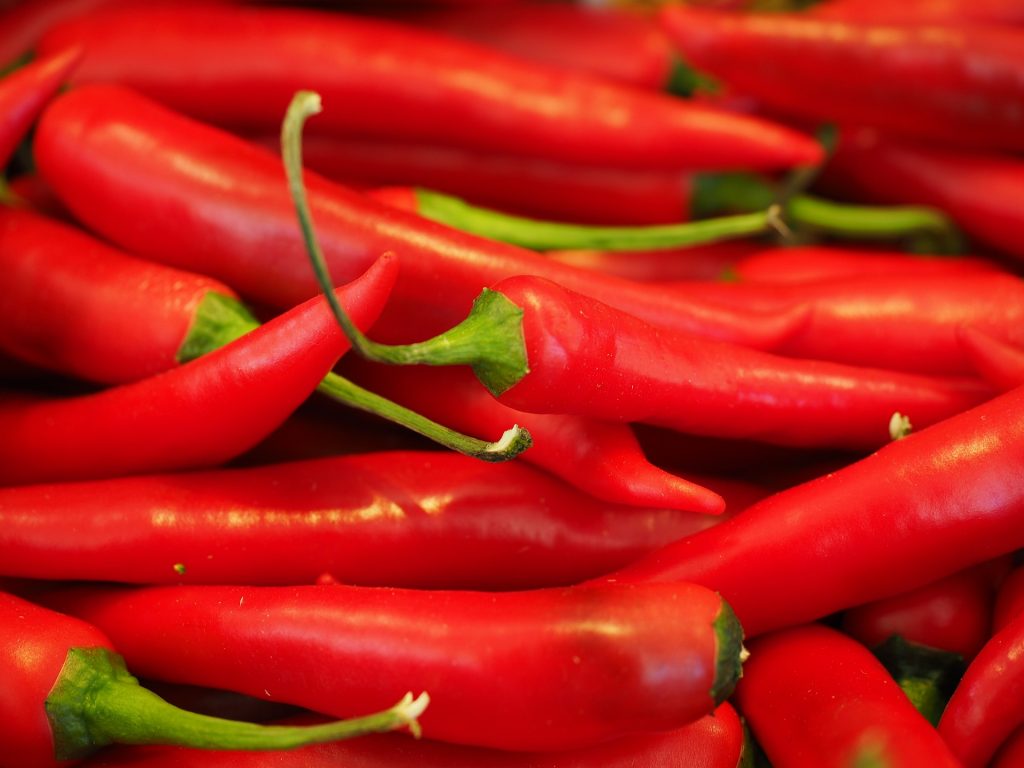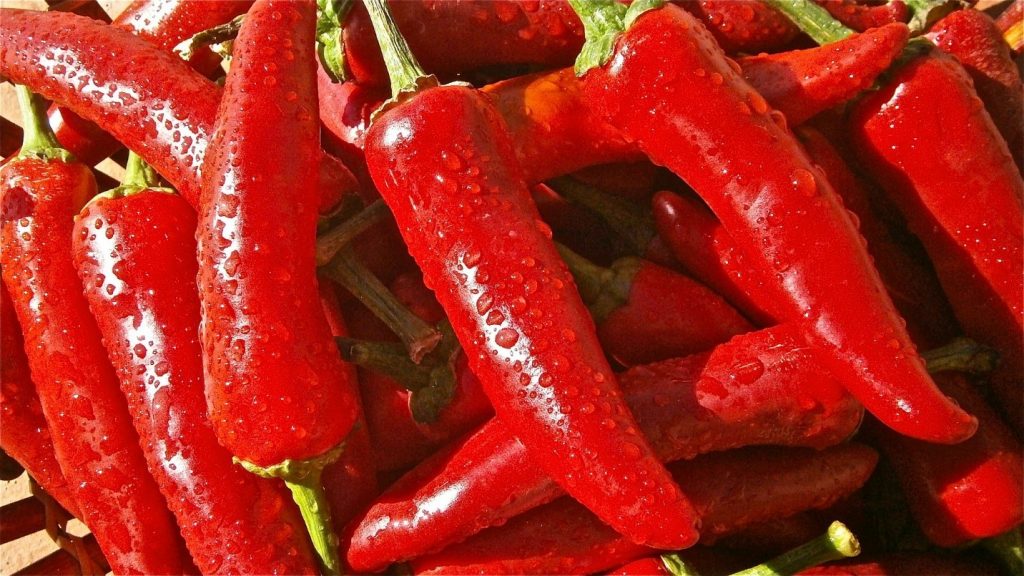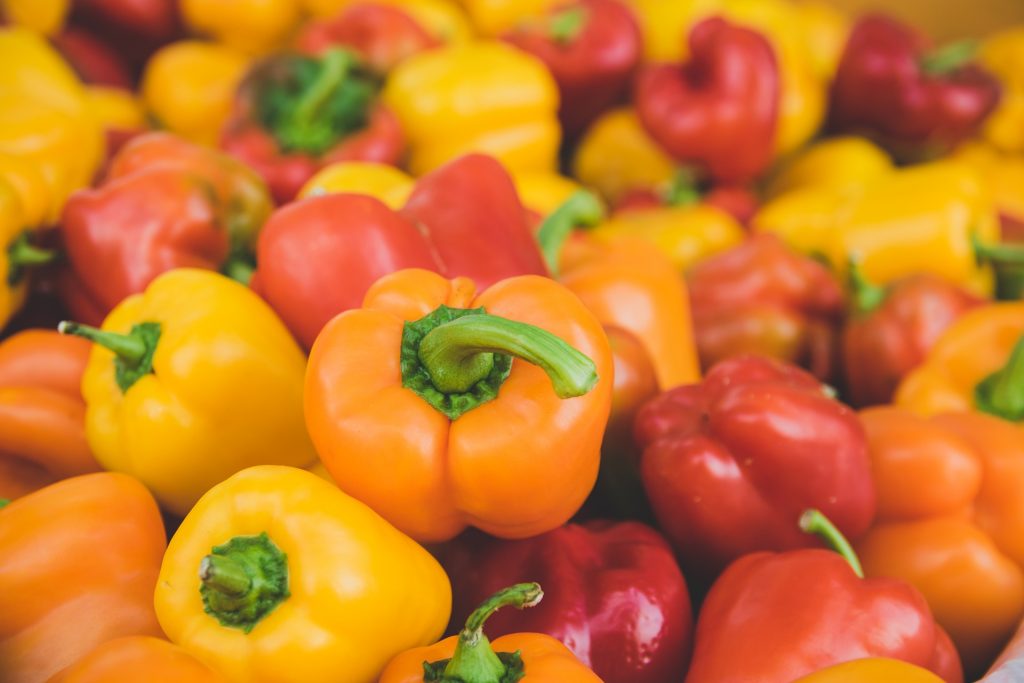Did you know?
Pepper pungency is rated in terms of “Scoville heat units.” Capsaicin is the compound responsible for the “hot” flavor of many peppers. Jalapeno and cayenne peppers range from 2,000 to 25,000 units, whereas Tabasco peppers range between 60,000 to 80,000 units. Green Bell peppers are rated 0 on the scale because they do not contain capsaicin.

As part of the Solanaceae family, peppers are close relatives to the tomato, potato, and eggplant. Peppers can be divided into two general categories, sweet peppers and chili peppers, and both were believed to have originated in South and Central America. The seeds of wild varieties have been dated back to 5000 BC. Spanish and Portuguese explorers carried the seeds of these fruits throughout the world in their travels. Peppers are very adaptable plants, thriving in both tropical and temperate regions. China, Europe, Turkey, Spain, Romania, Nigeria, and Mexico are currently the largest producers of peppers. A vast range of peppers may be grown in the home garden, for cooking as well as ornamental purposes. With thousands of varieties of peppers available, there is a flavor to suit everyone’s taste.
Seasonality
Late and early varieties of peppers are available in Colorado from July to October. Peppers are a warm season, tender vegetable often used to add flavor or ‘heat’ to cuisine. Peppers have tropical origin and thrive in warmer temperatures. Planting should be delayed until after the threat of frost in Colorado. Ideal temperatures are 70-80°F during the day and 60-70°F at night. Plants can be started indoors and transplanted after the threat of spring frost.
Selection
Choose peppers with the following characteristics:

- Full sized, firm, no wrinkling
- Stem partially or fully intact (to avoid internal rot)
- No extensive bruising, cuts, or wounds to the fruit
- No signs of freezing injury or sunscald.
Be sure to wear disposable gloves or thoroughly wash hands after cutting and handling hot peppers such as jalapeño, habanero, and other varieties. Avoid touching the eyes and face while handling peppers. If a severe reaction occurs, flush the skin and site of contact with cool water.
Handling
Like any other fruit or vegetable, peppers can be contaminated by bacteria from the soil, water, animals, or human sources. Wash peppers with cool, clean water prior to eating or preparing. Pat/rub dry with a paper towel. Peppers may have a food grade wax applied to reduce moisture loss and prevent bruising during shipment and storage. Peppers can be eaten raw, roasted, grilled, or added to a variety of dishes. Drying, freezing, and pickling peppers are the most effective ways to preserve peppers after the growing season is over.
Storage
In general, peppers have a fairly short shelf life of two to three weeks. For best quality, peppers should be properly stored and eaten within one to two weeks. Cool, humid conditions, such as those of your vegetable drawer in the refrigerator, should be sufficient to keep peppers fresh during storage. However, peppers are susceptible to chilling injury and should not be stored below 35°F.
Colorado Mix (Pickled Pepper Vegetable Blend)
- 2 1/2 pounds peppers, mild or hot as desired
- 1 pound cucumbers, cut into 1/2-inch chunks
- 2 to 4 carrots, cut into 1/2-inch chunks
- 1/2 pound cauliflower, cut into 1-inch florets
- 1 cup peeled pickling onions
- 7 to 14 garlic cloves, as desired
- 6 cups vinegar
- 3 cups water
- 2 tablespoons pickling salt
- 2 tablespoons sugar, if desired
Yield: Makes 7 to 8 pints
Procedure: Wash and prepare vegetables. Slit small peppers. Core large peppers and cut into strips. Remove blossom end of cucumbers and cut into chunks. Peel and chunk carrots. Break cauliflower into flowerettes. Pack vegetable medley into hot, sterilized jars, leaving 1/2-inch headspace. In 3-quart saucepan, bring vinegar, water, salt and sugar to a boil. Pour hot solution over mix in jars, leaving 1/4-inch headspace. Remove air bubbles. Add liquid to bring headspace to 1/4 inch. Wipe jar rims. Add pretreated lids and process in boiling water bath. For best flavor, store jars five to six weeks before opening.
Source: CSU Extension ‘Making Pickled Peppers’ Fact Sheet, see link below
Freezing Peppers

Select firm, crisp, thick-walled peppers. Wash and cut out stems. Cut in half and remove seeds. Cut into strips or rings, if desired. Spread in a single layer on a tray or cookie sheet. Place tray in the freezer for an hour or two. Loosen pepper pieces from tray and fill into freezer bags. Immediately place sealed bags back into the freezer. Pepper pieces will remain separated so that only a specific portion can be used for cooking needs.
Caution: Although peppers packed in oil are a popular preparation technique, this method cannot be used for long-term storage. Because packing peppers in oil increases the risk for bacterial growth and foodborne illness, they should either be stored refrigerated or used within 1 to 2 days of processing.
Nutrition

The nutritional properties of peppers range greatly depending on the variety and maturity. All peppers are a great source of Vitamin A and C. Red peppers contain lycopene and have been shown to reduce the risk for certain types of cancers. Red peppers are also an excellent source of vitamin B6. Bell peppers have a high concentration of beta-carotene which has been shown to reduce the risk for macular degeneration and cataracts. Green peppers also contain fiber, folate, and Vitamin K.


